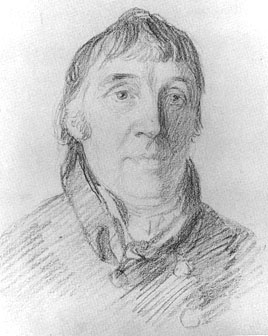| Thomas Stothard  Born: 17-Aug-1755 Born: 17-Aug-1755
Birthplace: London, England
Died: 27-Apr-1834
Location of death: London, England
Cause of death: unspecified
Gender: Male
Race or Ethnicity: White
Sexual orientation: Straight
Occupation: Painter Nationality: England
Executive summary: English subject painter English subject painter, born in London on the 17th of August 1755, the son of a well-to-do innkeeper in Long Acre. Being a delicate child, he was sent at the age of five to a relative in Yorkshire, and attended school at Acomb, and afterwards at Tadcaster and at Ilford in Essex. Showing a turn for drawing he was apprenticed to a draughtsman of patterns for brocaded silks in Spitalfields, and during his leisure hours he attempted illustrations to the works of his favorite poets. Some of these drawings were praised by Harrison, the editor of the Novelist's Magazine, and Stothard's master having died, he resolved to devote himself to art. In 1778 he became a student of the Royal Academy, of which he was elected associate in 1792 and full academician in 1794. In 1812 he was appointed librarian, having served as assistant for two years. He died in London on the 27th of April 1834.
Among his earliest book illustrations are plates engraved for Ossian and for Bell's Poets; and in 1780 he became a regular contributor to the Novelist's Magazine, for which he executed one hundred and forty-eight designs, including his eleven admirable illustrations to Peregrine Pickle and his graceful subjects from Clarissa and Sir Charles Grandison. He contentedly designed plates for pocket-books, tickets for concerts, illustrations to almanacs, portraits of popular players -- and into even the slightest and most trivial sketches he infused a grace and distinction which render them of value to the collectors of the present time. Among his more important series are the two sets of illustrations to Robinson Crusoe, one for the New Magazine and one for Stockdale's edition, and the plates to The Pilgrims Progress (1788), to Harding's edition of Oliver Goldsmith's Vicar of Wakefield (1792), to The Rape of the Lock (1798), to the works of Gessner (1802), to Cowper's Poems (1825), and to The Decameron; while his figure-subjects in the superb editions of Roger's Italy (1830) and Poems (1834) prove that even in latest age his fancy was still unexhausted, and his hand hardly at all enfeebled. He is at his best in subjects of a domestic or a gracefully ideal sort; the heroic and the tragic were beyond his powers. The designs by Stothard were estimated by R. N. Wornum to number five thousand, and of these about three thousand have been engraved. His oil pictures are usually small in size, and rather sketchy in handling. Their coloring is often rich and glowing, being founded upon the practice of Peter Paul Rubens, of whom Stothard was a great admirer. The "Vintage", perhaps his most important oil painting, is in the National Gallery. He was a contributor to Boydell's Shakespeare Gallery, but his best-known painting is the "Procession of the Canterbury Pilgrims", also in the National Gallery, the engraving from which, begun by Luigi and continued by Niccolo Schiavonetti and finished by James Heath, attained an immense popularity. The commission for this picture was given to Stothard by R. H. Cromek, and was the cause of a quarrel with his friend William Blake. It was followed by a companion work, the "Flitch of Bacon", which was drawn in sepia for the engraver but was never carried out in color.
In addition to his easel pictures, Stothard adorned the grand staircase of Burghley House, near Stamford, with subjects of War, Intemperance, and the Descent of Orpheus in Hell (1799-1803); the mansion of Hafod, North Wales, with a series of scenes from Froissart and Monstrelet (1810); the cupola of the upper hall of the Advocates' Library, Edinburgh (now occupied by the Signet Library), with Apollo and the Muses, and figures of poets, orators, etc. (1822); and he prepared designs for a frieze and other decorations for Buckingham Palace, which were not executed, owing to the death of King George IV. He also designed the magnificent shield presented to the Duke of Wellington by the merchants of London, and executed with his own hand a series of eight etchings from the various subjects which adorned it. In the British Museum is a collection, in four volumes, of engravings of Stothard's works, made by Robert Balmanno.
Son: Charles Alfred Stothard (antiquarian artist, b. 1786, d. 1821)
Royal Academy of Arts
Requires Flash 7+ and Javascript.
Do you know something we don't?
Submit a correction or make a comment about this profile
Copyright ©2019 Soylent Communications
|